Diary of a Rambling Antiquarian
Thursday, 21 September 2017
Hohhot Revisited
Last August I spent a few hours in Hohhot between trains, and had a disappointing time at the Nationalities Museum of Inner Mongolia University (内蒙古大学民族博物馆) where I had hoped to see their collection of five Khitan Small Script epitaphs. They were nowhere to be seen, and instead all we found were three fake Khitan Large Script epitaphs. This year I am spending a week and a half in Hohhot for the annual meeting of ISO/IEC JTC1/SC2 and WG2. The meeting is all next week, but I travelled up by train from Beijing yesterday as there are two pre-meetings on Shuishu (Sui script) and Naxi Dongba today, and a conference on Mongolian encoding issues at the weekend. Today's meetings (Shuishu in the morning and Naxi Dongba in the afternoon) are both being held at the Institute for Mongolian Studies (冡古学学院) at Inner Mongolia University. The institute is opposite the entrance to the Nationalities Museum that we visited last year.
Outside the entrance to the Institute for Mongolian Studies

As we go out through the lobby you can see in the photo above at lunchtime we notice a couple of inscribed stones hidden among the potted plants and some information boards for a temporary exhibition, and I make a mental note to investigate them when the meetings are over. In the afternoon, when we leave, I discover that there are actually five stones, and one of them is very exciting for me. I took a few photographs then, but most of the photographs below are from a few days later when I came back at lunchtime and I had the lobby to myself, and I could move the obstructions away in order to take clearer photos of the stones.
Lobby of the Institute for Mongolian Studies

Two inscribed stones partially obscured by pot plants and two completely hidden behind the information boards
Two stone monuments on display at the Institute of Mongolian Studies
On the far left, completely hidden by the information boards is a large stone prayer wheel with Buddhist inscriptions in Tibetan and Sanskrit. It's provenance is not indicated.
Stone Prayer Wheel
石制法轮 ᠴᠢᠯᠠᠭᠤᠨ ᠬᠣᠷᠯᠤ
To the right of the stone prayer wheel, also hidden from view, is a stone monument called the Taigong Dayuan Gushi Monument which was discovered in 1982 at Da'erjia Village (达尔架村) in Tümed Left Banner, on the western edge of Hohhot. There are two separate inscriptions in Mongolian and Chinese on the front and the back, but only the back side (facing the interior of the lobby) was photographable. On the top of the back side, only faintly visible in the photograph below, are two large Chinese characters: 碑隂 ("stele back"). Below that are inscriptions in Mongolian on the left, and in Chinese on the right. The monument is thought to date to the Wanli era (1573–1620) of the Ming dynasty.
Taigong Dayuan Gushi Monument
太公大元固什碑 ᠲᠠᠶᠢᠭᠦᠩ ᠳ᠋ᠠᠶᠦᠨ ᠬᠥᠰᠢ ᠶᠢᠨ ᠬᠥᠰᠢᠶᠡ
On the other side of the lobby is another stone monument which was discovered in 1982 at Da'erjia Village. This one, called the Bogd Chagan Lama Monument, is written entirely in Mongolian, and dates to the late Ming dynasty or early Qing dynasty. The inscription was written by the lama Perenglaijamsu (ᠫᠧᠷᠡᠩᠯᠠᠶᠢᠵᠠᠮᠰᠤ = Pulinglaizhamusu 普凌来扎木苏), and is a eulogy for the Bogd Chagan Lama (博格多察罕喇嘛) Rashijamsu (ᠷᠠᠰᠢᠵᠠᠮᠰᠤ = Laxizhamusu 拉西扎木苏) who died in 1627.
Bogd Chagan Lama Monument
博格多察罕喇嘛碑 ᠪᠣᠭᠳᠠ ᠴᠠᠭᠠᠨ ᠯᠠᠮᠠ ᠶᠢᠨ ᠬᠥᠰᠢᠶᠡ
On the far right, closest to the door, is a stone Buddhist monument inscribed with text in five different scripts (Lantsa, Tibetan, Phags-pa, Mongolian and Chinese). The monument was erected in 1580 (8th year of the Wanli era of the Ming dynasty) at the Huayan Temple by Baya'ut Ba'atur Taiji ᠪᠠᠶᠠᠭᠤᠳ ᠪᠠᠭᠠᠲᠤᠷ ᠲᠠᠶᠢᠵᠢ (摆腰把都儿台吉), the only son of Bayan Taiji, and a grandson of Altan Khan (1507–1582), leader of the Tümed Mongols. The monument was discovered in 1982 at the site of the Baozi Temple (堡子庙) in Sumuxin village (苏木沁村) 20 km east of Hohhot.
The Chinese text on the right side records the erection of the monument at Huayan Temple by Baya'ut [Ba'atur] Taiji in Wanli 8 [1580], and reads (unusually with the columns running from left to right): 封敕華嚴寺全 | 僧明來主文榜實 | 字板抄寫石板人 | 擺腰台吉□時起造 | 萬曆捌年四月十五日.
The Sanskrit text in large Lantsa letters reads (with a little help from my friend Viacheslav Zaytsev): || om̐ ā hūm̐ tram̐ hrī am̐ aḥ om̐ tare tam̐ || svāhā || (apparently om̐ tare tam̐ is the mantra of Red Tara).
Buddhist monument erected by Baya'ut Ba'atur Taiji in 1580
摆腰把秃儿台吉庙碑 ᠪᠠᠶᠠᠭᠤᠳ ᠪᠠᠭᠠᠲᠤᠷ ᠲᠠᠶᠢᠵᠢ ᠶᠢᠨ ᠰᠦᠮᠡ ᠶᠢᠨ ᠬᠥᠰᠢᠶᠡ
Finally, I come to the most important stone for me, which is standing next to the Baya'ut Ba'atur Taiji monument. This is a Liao dynasty tomb epitaph for Epitaph for Xiao Dilu 蕭敵魯 (1061–1114), written in the Khitan small script, and dated the 4th year of the Tianqing era [1114]. Xiao Dilu was a fifth generation descendant of the famous general, Xiao Talin 蕭撻凛 (?–1004), and he held the position of Vice Commissioner (副使).
Epitaph for Xiao Dilu (1114)
This is one of the five Khitan small script epitaphs held by the Nationalities Museum of Inner Mongolia University which I failed to find when I was passing through Hohhot last year. Later in the week I will ask a certain professor at Inner Mongolia University whether I can view the other four epitaphs, and he will assure me that they are all in storage in the basement of the museum, and are quite inaccessible to anyone. Funnily enough, I came across these photographs of the Khitan epitaphs in their inaccessible storage room. So next time I am at the museum I will be sure to look out for the door with a sign saying "Beware of the Leopard".
Khitan epitaphs in storage at Inner Mongolia University

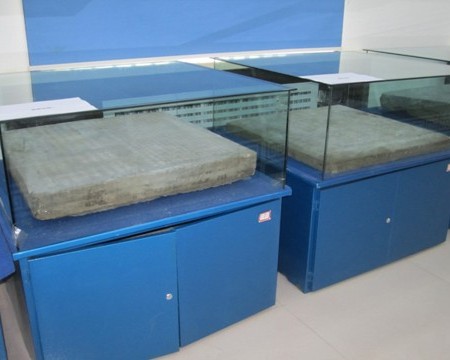
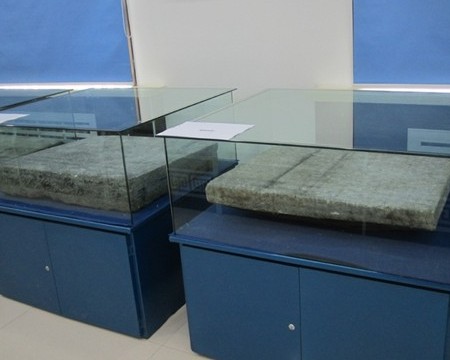
Inner Mongolia | Liao dynasty | Ming dynasty | Khitan | Mongolian | Phags-pa | Museums
Index of Rambling Antiquarian Blog Posts
Rambling Antiquarian on Google Maps
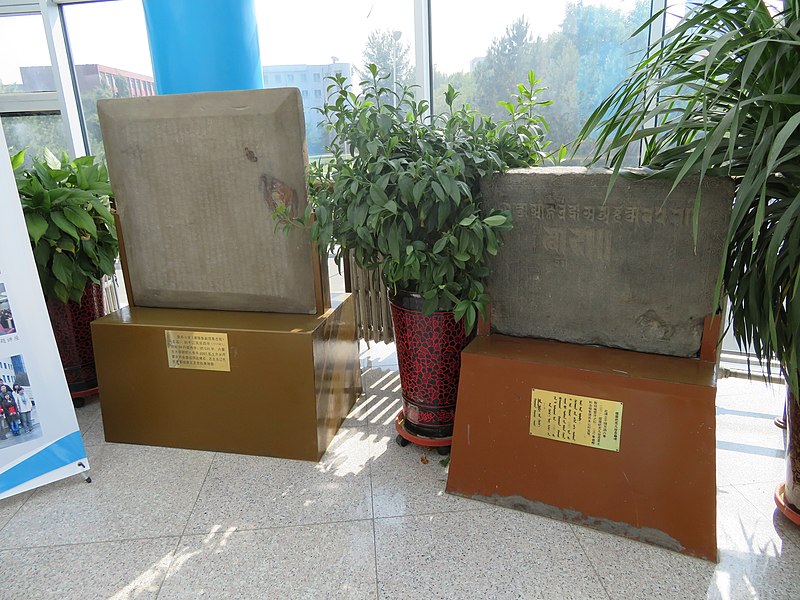
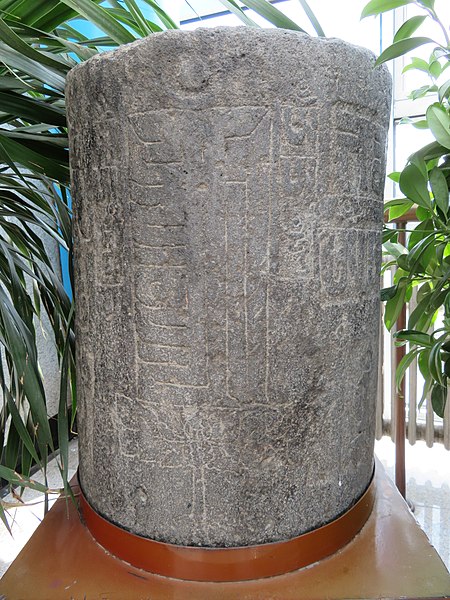

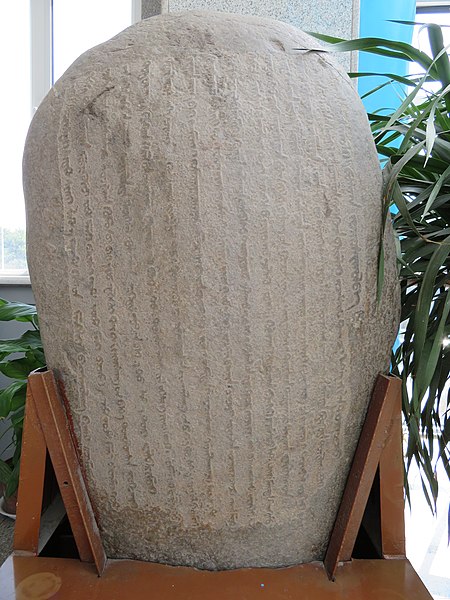
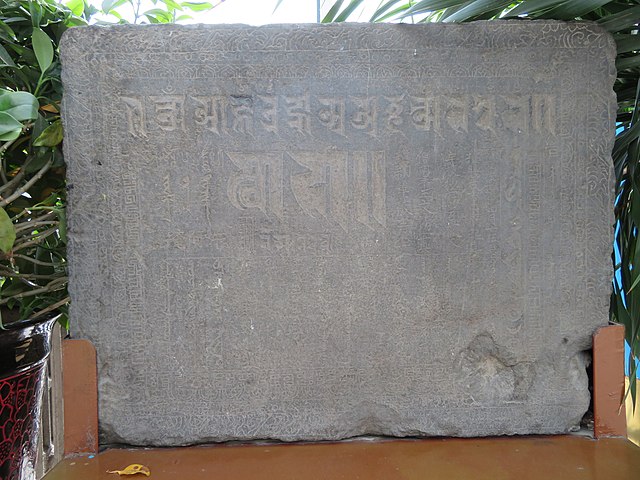
.jpg)